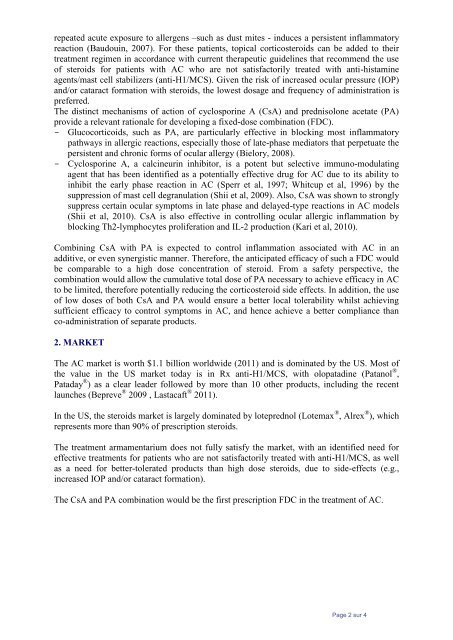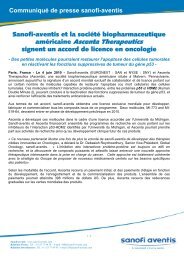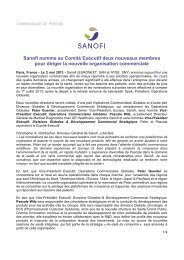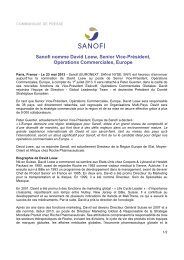FOV1101 Licensing opportunity - Sanofi
FOV1101 Licensing opportunity - Sanofi
FOV1101 Licensing opportunity - Sanofi
You also want an ePaper? Increase the reach of your titles
YUMPU automatically turns print PDFs into web optimized ePapers that Google loves.
epeated acute exposure to allergens –such as dust mites - induces a persistent inflammatory<br />
reaction (Baudouin, 2007). For these patients, topical corticosteroids can be added to their<br />
treatment regimen in accordance with current therapeutic guidelines that recommend the use<br />
of steroids for patients with AC who are not satisfactorily treated with anti-histamine<br />
agents/mast cell stabilizers (anti-H1/MCS). Given the risk of increased ocular pressure (IOP)<br />
and/or cataract formation with steroids, the lowest dosage and frequency of administration is<br />
preferred.<br />
The distinct mechanisms of action of cyclosporine A (CsA) and prednisolone acetate (PA)<br />
provide a relevant rationale for developing a fixed-dose combination (FDC).<br />
- Glucocorticoids, such as PA, are particularly effective in blocking most inflammatory<br />
pathways in allergic reactions, especially those of late-phase mediators that perpetuate the<br />
persistent and chronic forms of ocular allergy (Bielory, 2008).<br />
- Cyclosporine A, a calcineurin inhibitor, is a potent but selective immuno-modulating<br />
agent that has been identified as a potentially effective drug for AC due to its ability to<br />
inhibit the early phase reaction in AC (Sperr et al, 1997; Whitcup et al, 1996) by the<br />
suppression of mast cell degranulation (Shii et al, 2009). Also, CsA was shown to strongly<br />
suppress certain ocular symptoms in late phase and delayed-type reactions in AC models<br />
(Shii et al, 2010). CsA is also effective in controlling ocular allergic inflammation by<br />
blocking Th2-lymphocytes proliferation and IL-2 production (Kari et al, 2010).<br />
Combining CsA with PA is expected to control inflammation associated with AC in an<br />
additive, or even synergistic manner. Therefore, the anticipated efficacy of such a FDC would<br />
be comparable to a high dose concentration of steroid. From a safety perspective, the<br />
combination would allow the cumulative total dose of PA necessary to achieve efficacy in AC<br />
to be limited, therefore potentially reducing the corticosteroid side effects. In addition, the use<br />
of low doses of both CsA and PA would ensure a better local tolerability whilst achieving<br />
sufficient efficacy to control symptoms in AC, and hence achieve a better compliance than<br />
co-administration of separate products.<br />
2. MARKET<br />
The AC market is worth $1.1 billion worldwide (2011) and is dominated by the US. Most of<br />
the value in the US market today is in Rx anti-H1/MCS, with olopatadine (Patanol ® ,<br />
Pataday ® ) as a clear leader followed by more than 10 other products, including the recent<br />
launches (Bepreve ® 2009 , Lastacaft ® 2011).<br />
In the US, the steroids market is largely dominated by loteprednol (Lotemax ® , Alrex ® ), which<br />
represents more than 90% of prescription steroids.<br />
The treatment armamentarium does not fully satisfy the market, with an identified need for<br />
effective treatments for patients who are not satisfactorily treated with anti-H1/MCS, as well<br />
as a need for better-tolerated products than high dose steroids, due to side-effects (e.g.,<br />
increased IOP and/or cataract formation).<br />
The CsA and PA combination would be the first prescription FDC in the treatment of AC.<br />
Page 2 sur 4







